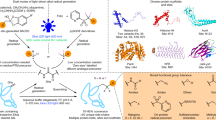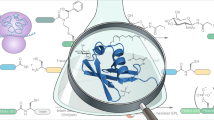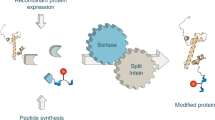Abstract
Methods for installing natural and unnatural amino acids and their modifications into proteins in a benign and precise manner are highly sought-after in protein science. Here we describe a protocol for 'post-translational mutagenesis' that enables the programmed installation of protein side chains through the use of rapid, mild and operationally simple free-radical chemistry performed on recombinantly expressed and purified proteins. By introduction of protein dehydroalanine (Dha) residues (in this instance, from a unique cysteine residue introduced by site-directed mutagenesis) as free-radical trapping 'tags' for downstream modification, exquisite control over the site of subsequent modification is achieved. Using readily available alkyl halide precursors and simple borohydride salts, alkyl radicals can be generated in aqueous solution. These alkyl radicals react rapidly with protein-bound Dha residues to yield functionalized protein products with new carbon–carbon bonds. Once the Dha is installed, the introduction of the desired functionality is limited only by the requirement for polarity matching of the generated radical with the Dha 'acceptor', the solubility of the alkyl halide precursors in aqueous solution and the kinetics of the reaction itself. For example, methylated derivatives of lysine, arginine and glutamine are readily accessible. Furthermore, as the side chains are constructed chemically, many unnatural modifications can also be directly introduced as part of the side chain, including isotope reporters (19F, 13C) that can be used in biophysical experiments such as protein NMR. From a suitable cysteine mutant of the target protein, the entire procedure for this chemical post-translational mutation takes 2 d and is readily performed by nonchemists.
This is a preview of subscription content, access via your institution
Access options
Access Nature and 54 other Nature Portfolio journals
Get Nature+, our best-value online-access subscription
$29.99 / 30 days
cancel any time
Subscribe to this journal
Receive 12 print issues and online access
$259.00 per year
only $21.58 per issue
Buy this article
- Purchase on Springer Link
- Instant access to full article PDF
Prices may be subject to local taxes which are calculated during checkout




Similar content being viewed by others
References
Walsh, C.T., Garneau-Tsodikova, S. & Gatto, G.J. Protein posttranslational modifications: the chemistry of proteome diversifications. Angew. Chem. Int. Ed. Engl. 44, 7342–7372 (2005).
Dawson, P.E., Muir, T.W., Clark-Lewis, I. & Kent, S.B. Synthesis of proteins by native chemical ligation. Science 266, 776–776 (1994).
Malins, L.R. & Payne, R.J. Recent extensions to native chemical ligation for the chemical synthesis of peptides and proteins. Curr. Opin. Chem. Biol. 22, 70–78 (2014).
Chin, J.W. Expanding and reprogramming the genetic code of cells and animals. Annu. Rev. Biochem. 83, 379–408 (2014).
Wang, L., Brock, A., Herberich, B. & Schultz, P.G. Expanding the genetic code of Escherichia coli. Science 292, 498–500 (2001).
Dumas, A., Lercher, L., Spicer, C.D. & Davis, B.G. Designing logical codon reassignment - expanding the chemistry in biology. Chem. Sci. 6, 50–69 (2015).
Chalker, J.M., Bernardes, G.J.L. & Davis, B.G. A 'tag-and-modify' approach to site-selective protein modification. Acc. Chem. Res. 44, 730–741 (2011).
van Kasteren, S.I. et al. Expanding the diversity of chemical protein modification allows post-translational mimicry. Nature 446, 1105–1109 (2007).
Bernardes, G.J., Chalker, J.M., Errey, J.C. & Davis, B.G. Facile conversion of cysteine and alkyl cysteines to dehydroalanine on protein surfaces: versatile and switchable access to functionalized proteins. J. Am. Chem. Soc. 130, 5052–5053 (2008).
Chalker, J.M. et al. Methods for converting cysteine to dehydroalanine on peptides and proteins. Chem. Sci. 2, 1666–1676 (2011).
Levengood, M.R. & van der Donk, W.A. Dehydroalanine-containing peptides: preparation from phenylselenocysteine and utility in convergent ligation strategies. Nat. Protoc. 1, 3001–3010 (2006).
Wang, J., Schiller, S.M. & Schultz, P.G. A biosynthetic route to dehydroalanine-containing proteins. Angew. Chem. Int. Ed. Engl. 46, 6849–6851 (2007).
Guo, J., Wang, J., Lee, J.S. & Schultz, P.G. Site-specific incorporation of methyl- and acetyl-lysine analogues into recombinant proteins. Angew. Chem. Int. Ed. Engl. 47, 6399–6401 (2008).
Chalker, J.M., Lercher, L., Rose, N.R., Schofield, C.J. & Davis, B.G. Conversion of cysteine into dehydroalanine enables access to synthetic histones bearing diverse post-translational modifications. Angew. Chem. Int. Ed. Engl. 124, 1871–1875 (2012).
Wright, T.H. et al. Posttranslational mutagenesis: a chemical strategy for exploring protein side-chain diversity. Science 354, aag1465 (2016).
Wright, T.H., Vallée, M.R.J. & Davis, B.G. From chemical mutagenesis to post-expression mutagenesis: a 50 year odyssey. Angew. Chem. Int. Ed. Engl. 55, 5896–5903 (2016).
Zheng, W. et al. Cellular stability of serotonin N-acetyltransferase conferred by phosphonodifluoromethylene alanine (Pfa) substitution for Ser-205. J. Biol. Chem. 280, 10462–10467 (2005).
Gunnoo, S.B. et al. Creation of a gated antibody as a conditionally functional synthetic protein. Nat. Commun. 5, 4388 (2014).
Yang, A. et al. A chemical biology route to site-specific authentic protein modifications. Science 354, 623–626 (2016).
Wang, J., Schiller, S.M. & Schultz, P.G. A biosynthetic route to dehydroalanine-containing proteins. Angew. Chem. Int. Ed. Engl. 119, 6973–6975 (2007).
Luger, K., Rechsteiner, T.J. & Richmond, T.J. Expression and purificationof recombinant histones and nucleosome reconstitution. Methods Mol. Biol. 119, 1–16 (1999).
Chooi, K.P. et al. Synthetic phosphorylation of p38α recapitulates protein kinase activity. J. Am. Chem. Soc. 136, 1698–1701 (2014).
Acknowledgements
T.H.W. was supported by the Rutherford Foundation. B.G.D. was supported by a Royal Society Wolfson Research Merit Award.
Author information
Authors and Affiliations
Contributions
B.G.D. and T.H.W. designed the research. T.H.W. performed the experiments. T.H.W. and B.G.D. wrote the paper.
Corresponding author
Ethics declarations
Competing interests
B.G.D. is a member of the Catalent Biologics Scientific Advisory Board. B.G.D. is one of the inventors on patent WO 2009103941, filed by the University of Oxford and assigned to Catalent Biologics. The patent covers, in one claim, reaction of the carbon–carbon double bond of dehydroalanine residues reacted with an organohalide in the presence of elemental zinc. The other authors declare no competing financial interests.
Integrated supplementary information
Supplementary Figure 1 Full mass spectra for H3 K9me2 prepared by chemical mutation.
Multiply charged ion series (above) and deconvoluted spectrum (below) for isolated H3 K9me2 prepared as described in this protocol.
Supplementary Figure 2 Full mass spectra for H3 S10Pfa prepared by chemical mutation.
Multiply charged ion series (above) and deconvoluted spectrum (below) for isolated H3 S10Pfa prepared as described in this protocol.
Supplementary information
Supplementary Text and Figures
Supplementary Figures 1 and 2. (PDF 271 kb)
Rights and permissions
About this article
Cite this article
Wright, T., Davis, B. Post-translational mutagenesis for installation of natural and unnatural amino acid side chains into recombinant proteins. Nat Protoc 12, 2243–2250 (2017). https://doi.org/10.1038/nprot.2017.087
Published:
Issue Date:
DOI: https://doi.org/10.1038/nprot.2017.087
This article is cited by
-
Posttranslational, site-directed photochemical fluorine editing of protein sidechains to probe residue oxidation state via 19F-nuclear magnetic resonance
Nature Protocols (2023)
-
Contemporary Approaches to α,β-Dehydroamino Acid Chemical Modifications
Chemical Research in Chinese Universities (2021)
-
Cysteine-specific protein multi-functionalization and disulfide bridging using 3-bromo-5-methylene pyrrolones
Nature Communications (2020)
-
Light-driven post-translational installation of reactive protein side chains
Nature (2020)
-
Engineering Thermostable Microbial Xylanases Toward its Industrial Applications
Molecular Biotechnology (2018)
Comments
By submitting a comment you agree to abide by our Terms and Community Guidelines. If you find something abusive or that does not comply with our terms or guidelines please flag it as inappropriate.



